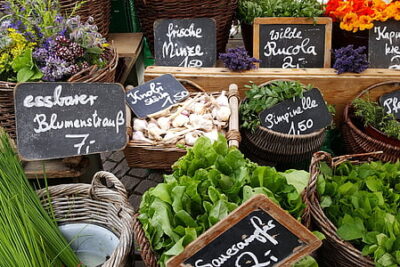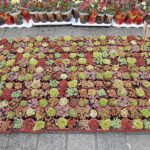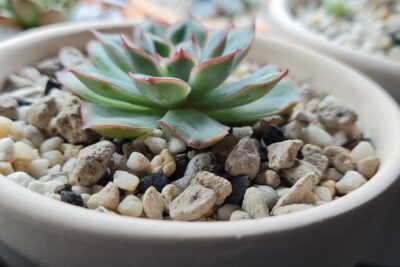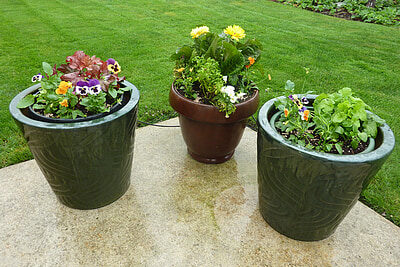
Succulents in Buddha's Temple: Symbolizing Resilience & Enlightenment

Succulents have become increasingly popular in recent years, not only for their unique and striking appearance, but also for their ability to thrive in harsh conditions. These resilient plants have captured the attention of many gardening enthusiasts and interior designers alike, with their ability to store water in their leaves and survive in dry climates. However, succulents also hold significant symbolism in various cultures and religions, with one notable example being their presence in Buddha's temples.
We will explore the significance of succulents in Buddha's temples and how they are used to convey deeper meanings. We will delve into the spiritual and philosophical connections between succulents and Buddhism, examining how these plants symbolize resilience and enlightenment. Additionally, we will discover the different types of succulents commonly found in Buddha's temples, and how they are cared for and incorporated into the temple environment. By the end, you will gain a deeper understanding of the cultural and symbolic significance of succulents in Buddha's temples, and the role they play in creating a serene and harmonious atmosphere.
- Succulents in Buddha's temple can symbolize resilience and enlightenment
- The presence of succulents in a temple can represent the ability to adapt and thrive in challenging conditions
- Succulents' ability to store water in their leaves can be seen as a metaphor for the ability to find inner strength and nourishment
- The low-maintenance nature of succulents can align with the teachings of simplicity and non-attachment in Buddhism
- The vibrant and unique shapes of succulents can reflect the diversity and beauty of the natural world
- The slow growth of succulents can symbolize patience and the journey towards enlightenment
- Having succulents in a temple can create a calming and peaceful atmosphere, promoting mindfulness and meditation
- Caring for succulents can serve as a meditative practice, encouraging a deeper connection with nature and oneself
- The presence of succulents can remind visitors of the impermanence of life and the importance of embracing change
- Frequently Asked Questions
Succulents in Buddha's temple can symbolize resilience and enlightenment
Succulents are not only beautiful and low-maintenance plants, but they can also carry deep symbolism. When placed in Buddha's temple, succulents can represent resilience and enlightenment.
Resilience is the ability to bounce back from difficult situations and adapt to change. Succulents are a perfect embodiment of this trait. Their thick leaves and stems allow them to store water, making them incredibly resilient to drought and harsh conditions. Just like how these plants can survive in challenging environments, we too can find strength in adversity and thrive.
Enlightenment, on the other hand, is the state of ultimate wisdom and spiritual awakening. Buddha's teachings emphasize the importance of seeking enlightenment to free ourselves from suffering. Succulents, with their unique growth patterns and ability to thrive in various conditions, can serve as a reminder of our own journey towards self-discovery and spiritual growth.
Symbolism of Succulents in Buddha's Temple
When succulents are placed in Buddha's temple, they can enhance the ambiance and create a serene atmosphere. Their presence adds a touch of natural beauty and vitality to the sacred space, inviting visitors to connect with nature and find inner peace.
The symbolism of succulents in Buddha's temple goes beyond their physical attributes. Each variety of succulent carries its own symbolism, further enriching the spiritual experience. For example, the Jade Plant (Crassula ovata) is believed to attract wealth and good fortune, while the Aloe Vera plant symbolizes healing and protection.
 Where to Find a Variety of Succulent Plants at Home Depot
Where to Find a Variety of Succulent Plants at Home DepotUsing Succulents in Temple Decor
There are various ways to incorporate succulents into the decor of Buddha's temple. Here are a few ideas:
- Altar Arrangements: Create beautiful arrangements using different types of succulents and place them on the altar. This can be a focal point of the temple, symbolizing resilience and enlightenment.
- Potted Displays: Use decorative pots and planters to display individual succulents throughout the temple. This can add a touch of greenery and tranquility to different corners of the space.
- Hanging Gardens: Hang small pots or glass terrariums filled with succulents from the ceiling or walls. This creates a unique visual display and maximizes the use of space.
Remember to choose succulents that are well-suited for the temple's lighting and temperature conditions. Additionally, regular care and maintenance, such as watering and occasional pruning, will ensure the succulents stay healthy and vibrant.
By incorporating succulents into Buddha's temple, we not only enhance the visual appeal but also infuse the space with meaningful symbolism. These resilient and enlightening plants serve as a constant reminder of our own journey towards resilience, enlightenment, and inner peace.
The presence of succulents in a temple can represent the ability to adapt and thrive in challenging conditions
When you step into Buddha's Temple, you may notice a beautiful display of succulents adorning the surroundings. These resilient plants, with their ability to store water and survive in harsh environments, serve as a powerful symbol of resilience and enlightenment.
Succulents, with their unique ability to adapt and thrive in challenging conditions, are a perfect representation of the teachings of Buddha. Just as these plants can endure extreme temperatures and scarce water resources, so too can individuals find the strength within themselves to overcome adversity and flourish.
The symbolism of succulents in Buddhism
In Buddhism, succulents are often associated with the concept of enlightenment. The journey towards enlightenment is not always smooth, and individuals face numerous obstacles along the way. The presence of succulents in Buddha's Temple serves as a reminder that like these plants, we too can find the resilience and perseverance necessary to overcome challenges.
 Ultimate Guide: Top Places to Buy Succulents for Mother's Day
Ultimate Guide: Top Places to Buy Succulents for Mother's DayFurthermore, succulents are known for their ability to propagate and create new life from their own leaves. This process mirrors the cycle of rebirth and the continuous cycle of life and death emphasized in Buddhist teachings. The presence of succulents in the temple reinforces the importance of embracing change and transformation as an integral part of spiritual growth.
The calming effect of succulents in a temple environment
In addition to their symbolic significance, succulents also contribute to creating a serene and peaceful atmosphere within Buddha's Temple. The soothing green hues and unique shapes of these plants have a calming effect on visitors, promoting a sense of tranquility and mindfulness.
As one gazes upon the succulents in Buddha's Temple, the mind can begin to quiet itself, enabling individuals to focus on their spiritual practice and cultivate a deeper connection with themselves and the teachings of Buddha.
Whether it is the resilience they embody, the symbolism they represent, or the calming presence they provide, succulents in Buddha's Temple serve as a visual reminder of the potential for growth, resilience, and enlightenment that lies within each of us.
Succulents' ability to store water in their leaves can be seen as a metaphor for the ability to find inner strength and nourishment
When we think of succulents, we often associate them with their unique ability to store water in their leaves, stems, or roots. This adaptation allows them to survive in arid environments where water is scarce. But beyond their physical resilience, succulents hold a deeper symbolic meaning that resonates with the human spirit.
Like succulents, human beings have an innate capacity to find inner strength and nourishment, even in the most challenging circumstances. The ability to store water within themselves is a metaphor for the resilience and resourcefulness we possess as individuals.
 Discover a Variety of Homemade Succulent Food Recipes for Every Palate
Discover a Variety of Homemade Succulent Food Recipes for Every PalateJust as succulents thrive in harsh conditions, so too can we flourish in the face of adversity. These resilient plants remind us that we have the power to adapt, grow, and overcome obstacles. They serve as a reminder that even in the driest of times, there is always a wellspring of strength within us.
The Connection to Enlightenment
In addition to their association with resilience, succulents also hold a connection to the concept of enlightenment. In various spiritual traditions, the image of Buddha is often depicted surrounded by lush greenery, including succulent plants.
This symbolism stems from the belief that succulents represent the ability to thrive and find peace within oneself. Just as the succulent's ability to store water allows it to sustain life, the cultivation of inner peace and enlightenment allows individuals to find fulfillment and contentment.
By incorporating succulents into Buddha's temple and other sacred spaces, practitioners are reminded of the path towards enlightenment. The presence of these plants serves as a visual reminder of the journey towards inner peace, resilience, and self-discovery.
The Lessons from Succulents
The presence of succulents in Buddha's temple offers valuable lessons for our own lives:
- Resilience: Just like succulents, we can adapt and thrive in challenging environments.
- Inner Strength: We have the capacity to find nourishment and strength from within, even when external circumstances are difficult.
- Enlightenment: By cultivating inner peace, we can find fulfillment and contentment in our lives.
Next time you come across a succulent, take a moment to appreciate its beauty and consider the profound symbolism it holds. Let it serve as a reminder of your own resilience and the potential for enlightenment that resides within you.
The low-maintenance nature of succulents can align with the teachings of simplicity and non-attachment in Buddhism
 Discover the Best Succulent Nursery in San Diego for Your Green Oasis
Discover the Best Succulent Nursery in San Diego for Your Green OasisSucculents, with their ability to thrive in arid conditions and their low-maintenance requirements, can be seen as a perfect representation of the teachings of simplicity and non-attachment in Buddhism. Just as succulents are able to flourish with minimal care and resources, Buddhists strive to live a simple and uncluttered life, detached from material possessions and desires.
Like succulents, which store water in their leaves and stems to survive in dry environments, Buddhists aim to cultivate inner resilience and adaptability. The thick, fleshy leaves of succulents symbolize the ability to sustain oneself during challenging times, just as Buddhists seek to develop mental and emotional strength to endure the ups and downs of life.
The symbolism of succulents in Buddha's temple
In Buddhist temples, succulents are often used as decorative elements, their presence serving as a reminder of the principles and teachings of Buddhism. Placing succulents in Buddha's temple aligns with the belief in impermanence and the importance of being in the present moment.
Succulents, with their unique ability to retain water, represent the impermanence of life. Just as the water stored in the leaves of succulents eventually evaporates or is absorbed, life itself is transient and ever-changing. By observing the succulents in Buddha's temple, practitioners are reminded to embrace the impermanence of life and appreciate the present moment.
Succulents as a symbol of enlightenment
The resilience and adaptability of succulents also make them a symbol of enlightenment in Buddhism. Just as succulents have evolved to thrive in harsh conditions, Buddhists strive to develop wisdom and insight to overcome the challenges and suffering of existence.
Furthermore, succulents' ability to propagate and generate new life from their leaves or stems parallels the Buddhist belief in rebirth and the continuous cycle of existence. This symbolism reinforces the idea that enlightenment is not a final destination but an ongoing process of growth and transformation.
- Resilience: Succulents' ability to survive in harsh environments parallels the mental and emotional strength cultivated by Buddhists.
- Adaptability: The capacity of succulents to thrive with minimal resources reflects the Buddhist principle of non-attachment to material possessions.
- Impermanence: Succulents' transient nature symbolizes the impermanence and ever-changing nature of life, reminding Buddhists to appreciate the present moment.
- Enlightenment: The resilience, adaptability, and regenerative abilities of succulents mirror the qualities sought after in the pursuit of enlightenment.
The vibrant and unique shapes of succulents can reflect the diversity and beauty of the natural world
 Discover Local Succulent Sales: Find the Best Deals Near You!
Discover Local Succulent Sales: Find the Best Deals Near You!Succulents are a popular choice for indoor and outdoor gardens due to their vibrant colors and unique shapes. These plants have the ability to store water in their leaves, stems, and roots, allowing them to survive in arid and desert environments. This natural adaptation is what gives succulents their distinctive appearance and makes them such resilient plants.
Just as succulents have the ability to withstand harsh conditions, they can also symbolize resilience and strength in our own lives. The diverse range of succulent species and varieties mirrors the diversity found in nature, reminding us of the beauty that can be found in differences.
One place where succulents can be found in abundance is in Buddha's temples. These temples, known for their serene and peaceful atmospheres, often feature carefully cultivated gardens filled with a variety of plants, including succulents. The presence of succulents in these sacred spaces can hold symbolic meaning, representing resilience and enlightenment.
Succulents as a symbol of resilience
Resilience is the ability to bounce back from challenges and adapt to new circumstances. Succulents exemplify this quality through their ability to survive in harsh environments, where other plants would struggle to grow. Their ability to store water in their leaves allows them to endure periods of drought, symbolizing the power to overcome adversity.
By incorporating succulents into our own living spaces, we can be reminded of our own resilience and the strength we possess to overcome obstacles. These plants serve as a constant reminder that even in the face of adversity, we have the capacity to grow and thrive.
Succulents as a symbol of enlightenment
Enlightenment is often associated with wisdom, clarity, and spiritual growth. The presence of succulents in Buddha's temples can be seen as a representation of this pursuit of enlightenment. Just as succulents grow towards the light, seeking nourishment and energy, humans also strive for knowledge and spiritual growth.
The unique shapes and patterns of succulents can serve as a visual reminder of the intricate and complex nature of the journey towards enlightenment. Each succulent is unique, with its own distinct shape and growth pattern, just like each individual's path towards self-discovery and enlightenment.
 Find Your Perfect Day of the Dead Succulents: Festive Plants!
Find Your Perfect Day of the Dead Succulents: Festive Plants!By incorporating succulents into Buddha's temples, these sacred spaces become not only a place of meditation and reflection but also a reminder of the ongoing quest for enlightenment.
The slow growth of succulents can symbolize patience and the journey towards enlightenment
Succulents, with their slow and steady growth, can serve as a powerful symbol of patience and the journey towards enlightenment. Just like the path to spiritual awakening, succulents require time, care, and nurturing to flourish.
These resilient plants have the ability to store water in their leaves and stems, allowing them to survive in arid conditions. This adaptation can be seen as a metaphor for the human spirit's ability to endure and thrive even in the most challenging circumstances.
Resilience in the face of adversity
Just as succulents can withstand harsh environments, they can also teach us to be resilient in the face of adversity. Their ability to adapt to various conditions reminds us of our own capacity to overcome obstacles and grow stronger through life's challenges.
By observing the growth of succulents, we can learn to be patient and trust in the natural process of life. Their slow and steady progress encourages us to embrace the journey rather than rushing towards a destination.
Symbolizing enlightenment
Within the serene environment of Buddha's temple, succulents can serve as a visual representation of enlightenment. The simplicity and tranquility of these plants reflect the peaceful state of mind that is often associated with spiritual awakening.
Their modest appearance and minimalistic nature remind us to let go of materialistic attachments and embrace a more mindful way of living. As we care for these plants, we are also reminded to nurture our own spiritual growth and seek inner peace.
 Elevate Your Home Décor with Chic Succulent Plant Pots
Elevate Your Home Décor with Chic Succulent Plant PotsSucculents in Buddha's temple not only add beauty to the surroundings but also convey profound symbolism. They teach us the values of resilience, patience, and enlightenment. By incorporating these plants into the temple, we create a space that not only honors nature but also serves as a reminder of our own spiritual journey.
Having succulents in a temple can create a calming and peaceful atmosphere, promoting mindfulness and meditation
Having succulents in a temple can create a calming and peaceful atmosphere, promoting mindfulness and meditation. The presence of these resilient plants not only adds beauty to the space but also carries symbolic significance that aligns with the teachings of Buddha.
Succulents symbolize resilience
One of the key characteristics of succulents is their ability to survive in harsh and arid conditions. They have adapted to store water in their leaves, stems, and roots, enabling them to withstand long periods of drought. This resilience mirrors the teachings of Buddha, who emphasized the importance of inner strength and perseverance in the face of life's challenges.
Succulents represent enlightenment
Another symbolic connection between succulents and Buddha's teachings is their ability to thrive in simplicity. Succulents have a minimalist beauty, with their unique shapes and vibrant colors. This simplicity aligns with the concept of enlightenment, which encourages individuals to detach themselves from material desires and find contentment in the present moment.
 Find the Perfect Mini Succulent Wedding Favors for Your Unique Day
Find the Perfect Mini Succulent Wedding Favors for Your Unique DaySucculents as reminders of impermanence
Additionally, succulents serve as reminders of the impermanence of life. Just as succulents go through cycles of growth and dormancy, life itself is a constant process of change. Buddha taught that attachment to the transient nature of existence leads to suffering, and by embracing impermanence, one can find peace and freedom.
Creating a mindful space with succulents
By incorporating succulents into a temple's design, practitioners and visitors are reminded of the wisdom and teachings of Buddha. The presence of these resilient plants fosters a sense of tranquility and encourages a deeper connection with oneself and the present moment. Whether placed in traditional pots or arranged in a Zen garden, succulents can enhance the ambiance and promote a mindful environment for meditation and reflection.
Caring for succulents can serve as a meditative practice, encouraging a deeper connection with nature and oneself
When it comes to finding inner peace and tranquility, many people turn to various practices such as meditation, yoga, or even spending time in nature. However, one often overlooked practice that can promote a sense of calm and mindfulness is caring for succulents.
Succulents, with their unique and captivating beauty, can serve as a powerful symbol of resilience and enlightenment. These hardy plants have adapted to thrive in arid and harsh environments, showcasing their ability to withstand and overcome challenges. Just like succulents, we too can learn to navigate through life's difficulties and emerge stronger.
 Top Hanging Succulents: Discover Which Thrive as Hanging Strings
Top Hanging Succulents: Discover Which Thrive as Hanging StringsEmbracing Resilience
One of the key lessons succulents teach us is the importance of resilience. These plants have evolved to store water in their leaves, stems, or roots, allowing them to survive in dry and unforgiving conditions. Similarly, in our own lives, we encounter obstacles and setbacks that require us to tap into our inner strength and bounce back.
By caring for succulents, we can witness their remarkable ability to adapt and grow even in challenging circumstances. This serves as a gentle reminder that we too possess the resilience to overcome adversity and thrive.
Connecting with Nature
As we tend to our succulents, we are presented with an opportunity to connect with nature on a deeper level. The act of nurturing these plants, observing their growth, and providing them with the right conditions can be a meditative practice in itself.
Whether it's gently watering them, ensuring they receive adequate sunlight, or repotting them when necessary, these actions allow us to be fully present in the moment and cultivate a sense of mindfulness. As we engage in these activities, we become more attuned to the natural rhythms of life and develop a greater appreciation for the beauty and resilience found in the plant kingdom.
Finding Enlightenment
In Buddhism, the image of Buddha surrounded by lush greenery and serene landscapes is commonly depicted. The presence of succulents in Buddha's temple further emphasizes the connection between these plants and the pursuit of enlightenment.
Just as Buddha sought enlightenment under the Bodhi tree, succulents can serve as a physical reminder of our own journey towards self-discovery and spiritual growth. Their ability to thrive in challenging conditions symbolizes the resilience required to transcend obstacles and find inner peace.
By incorporating succulents into our lives, we can create a sacred space that fosters a sense of tranquility and encourages personal reflection. As we care for these plants, we not only nurture their growth but also cultivate our own sense of resilience and enlightenment.
 Explore Mountain Crest Gardens' Collection for Stunning Succulents
Explore Mountain Crest Gardens' Collection for Stunning SucculentsThe presence of succulents can remind visitors of the impermanence of life and the importance of embracing change
Succulents, with their ability to thrive in harsh conditions and retain water in their fleshy leaves, have become popular symbols of resilience. In the serene setting of Buddha's Temple, these resilient plants serve as a powerful reminder of the impermanence of life and the importance of embracing change.
As visitors enter the temple, they are greeted by an array of succulents carefully arranged in various shapes and sizes. These plants, with their unique ability to adapt and survive in challenging environments, mirror the teachings of Buddha himself.
The symbolism of succulents in the temple
Within the Buddhist philosophy, impermanence (known as "anicca") is a fundamental concept. It emphasizes that all things in life are transient and subject to change. The presence of succulents in Buddha's Temple acts as a visual representation of this concept.
Just like the succulents, which endure harsh conditions and still manage to thrive, individuals can learn to navigate life's challenges and find beauty in the face of adversity. These plants serve as a gentle reminder that even in the most difficult times, there is always the potential for growth and enlightenment.
Resilience and enlightenment
The resilience of succulents is often seen as a metaphor for the journey towards enlightenment. Similar to how these plants withstand harsh climates, individuals on the path of spiritual awakening must overcome obstacles and endure hardships to reach a state of enlightenment.
By observing the succulents in Buddha's Temple, visitors can reflect on their own journey and find inspiration to persevere. The presence of these plants encourages a sense of resilience, reminding individuals that they too can withstand difficulties and emerge stronger.
Embracing change and letting go
Another lesson that succulents can teach us is the importance of embracing change. These plants have the remarkable ability to adapt and grow in response to their environment. In the same way, individuals must learn to let go of attachments and embrace the inevitable changes that life brings.
As visitors observe the succulents' ability to let go of old leaves and grow new ones, they are encouraged to reflect on their own attachments and the need for flexibility. The presence of succulents in Buddha's Temple serves as a gentle reminder to embrace change and let go of what no longer serves us.
The presence of succulents in Buddha's Temple not only adds to the aesthetic beauty but also carries deep symbolism. These resilient plants remind visitors of the impermanence of life, the journey towards enlightenment, and the importance of embracing change. As we admire these succulents, we are encouraged to reflect on our own lives and find inspiration to cultivate resilience and embrace the ever-changing nature of existence.
Frequently Asked Questions
1. What are succulents?
Succulents are plants that have thick, fleshy leaves or stems that are capable of storing water. They are known for their ability to survive in arid conditions.
2. Why are succulents popular in Buddha's temples?
Succulents are often used in Buddha's temples because they symbolize resilience and enlightenment. Their ability to store water represents the ability to endure and thrive in challenging environments.
3. How do succulents represent resilience?
Succulents are able to withstand harsh conditions such as drought and extreme temperatures. Their ability to survive and thrive in such environments is seen as a symbol of resilience and strength.
4. What is the significance of succulents in relation to enlightenment?
In Buddhism, enlightenment is often associated with the ability to see things as they truly are and to transcend suffering. The hardy nature of succulents represents the ability to endure and overcome obstacles on the path to enlightenment.
If you want to read more articles similar to Succulents in Buddha's Temple: Symbolizing Resilience & Enlightenment, you can visit the Planters and Arrangements category.






You Must Read